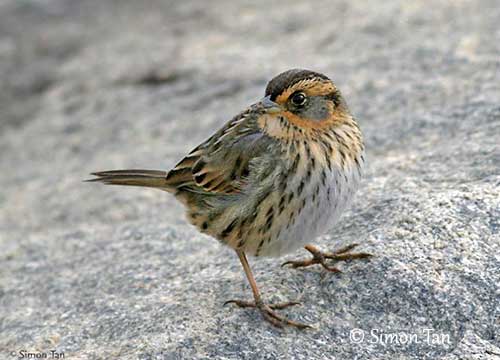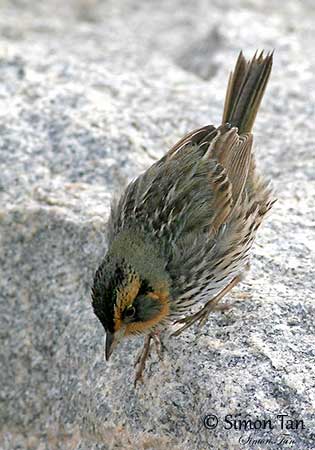
Fr: Bruant à queue aiguë
Ang: Saltmarsh Sparrow - Saltmarsh Sharp-tailed Sparrow
All: Spitzschwanzammer
Esp: Chingolo Colifino
Ita: Passero coda acuta
Nd: Spitsstaartgors
Sd: Spetsstjärtad sparv
Photographer:
Simon Tan
PBase Bird galleries
Text by Nicole Bouglouan
Sources:
HANDBOOK OF THE BIRDS OF THE WORLD Vol 16 by Josep del Hoyo- Andrew Elliot-David Christie – Lynx Edicions – ISBN: 9788496553781
FIELD GUIDE TO THE BIRDS OF NORTH AMERICA - National Geographic Society - ISBN: 0792274512
All About Birds (Cornell Lab of Ornithology)
What Bird-The ultimate Bird Guide (Mitchell Waite)
BBC - Earth News – Reporting Life on Earth
University of Connecticut – Saltmarsh Sparrow
Bull, Milan G., "Saltmarsh Sparrow" (2013).Wrack Lines. Paper 94.
Conserve Wildlife - New Jersey Endangered and Threatened Species Field Guide
CCB - Southern range limit for breeding in the saltmarsh sparrow
Saltmarsh Sparrow
Ammodramus caudacutus
Passeriformes Order – Passerellidae Family
INTRODUCTION:
The genus Ammodramus is included in the « grassland sparrows » clade. Following molecular data, Ammodramus is divided into two groups, the “grassland” group and the “marshland” group. The Saltmarsh Sparrow belongs to the latter with three other species, the Seaside Sparrow (A. maritimus), the Nelson’s Sparrow (A. nelsoni) and the Le Conte’s Sparrow (A. leconteii). Until 1995, the Saltmarsh Sparrow and the Nelson’s Sparrow were a single species, known as the Sharp-tailed Sparrow.
It frequents the coastal salt marshes with aquatic vegetation. It feeds and breeds in this type of habitat, and can be seen walking, running and hopping along the ground while foraging for various invertebrates and seeds.
The Saltmarsh Sparrow has unusual mating system for a songbird. The male is not territorial and spends most of its time singing to attract females because it is polygamous. But even with similar behaviour, the female performs all the nesting duties.
This species is threatened by habitat loss throughout the range on the E coast of USA, and is currently listed as Vulnerable.

DESCRIPTION OF THE BIRD:
Biometrics:
Length: 11,5-13 cm
Wingspan: 189 cm
Weight: 15-23 g
The Saltmarsh Sparrow adult of nominate race has greyish streaked white mantle and upper back, whereas lower back, rump and uppertail-coverts are brown with buffy edges. The short tail is buffy brown with sharply pointed feathers. The upperwing is brown with white, black, grey and buff markings, but the flight-feathers are mostly blackish.
On the underparts, the throat is white. Breast and flanks are pale buff with blackish streaking. The belly is white and the undertail-coverts are pale buffy with some black streaks.
On the head, there is an indistinct grey median stripe on crown, bordered by two dark brown lateral stripes. Supercilium and submoustachial stripe are orange-buff. Ear-coverts and nape are grey.
The pointed bill is dark horn on the upper mandible and pale yellowish on the lower mandible. The eyes are dark brown, surrounded by narrow, buffy-white eyering. Legs and feet are flesh-coloured.
Male and female are similar.
The juvenile resembles adults but buffer, and the underparts are finely, but more heavily streaked.
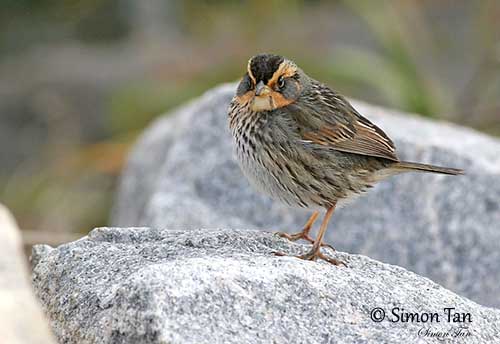
SUBSPECIES AND RANGE:
The Saltmarsh Sparrow has two subspecies.
A.c. caudacutus (described) breeds in NE USA from S Maine S along the coast of New Jersey. Non-breeding areas are mainly from New Jersey S to N and W Florida.
A.c. diversus breeds from coastal New Jersey S to Delmarva Peninsula. Non-breeding areas occur from breeding range S to NE Florida, and probably to Louisiana. This race resembles nominate but it has slightly smaller bill and darker upperparts.
HABITAT:
The Saltmarsh Sparrow frequents the coastal salt marshes with aquatic vegetation including sedges (carex), rushes, cord grass (Spartina alterniflora) and salt grass (Distichlis spicata) which are important food sources for the birds. But the species can also be seen in wet meadows, sometimes in fresh marshes or fields near the coasts.
CALLS AND SONGS: SOUNDS BY XENO-CANTO
The Saltmarsh Sparrow utters a buzz while it is flying low over the grass “tuptup-sheeeee”. The song is a soft, rapid series of fading gurgles and hisses, usually wheezy phrases “ts-ts-sssss-tsik”. Only the male sings.
The call is a sharp “tsick” often repeated, and “chip” notes.
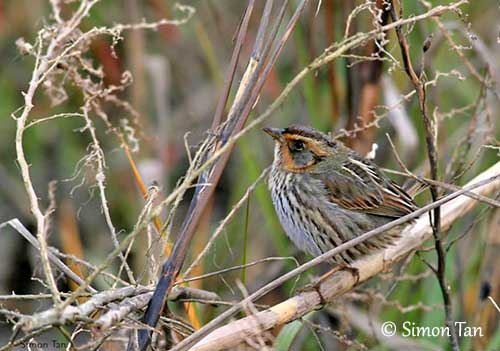
BEHAVIOUR IN THE WILD:
The Saltmarsh Sparrow feeds mainly on various invertebrates and seeds while foraging in marshes. Insect diet includes grasshoppers, beetles, caterpillars, ants, wasps and others. But it also takes spiders and numerous aquatic invertebrates such as amphipods, small crabs, snails and marine worms.
Animal matter is taken all year round and especially during summer while nesting. During autumn and winter, it feeds mainly on seeds of grasses and aquatic plants.
The Saltmarsh Sparrow walks, runs and hops along the ground when foraging, and it also climbs in marsh vegetation. It may sometimes probe in mud, but usually, it picks the preys from ground, water surface and plants.
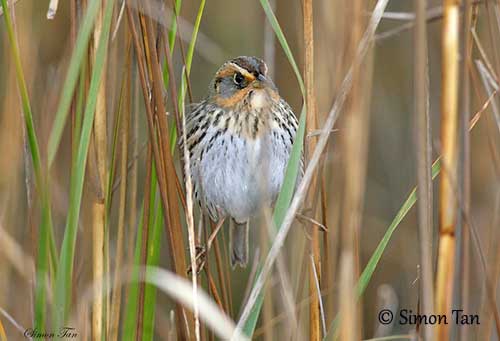
During the breeding season, the Saltmarsh Sparrow shows unusual mating system for songbirds. Both sexes are promiscuous, and the male spends most of time singing to attract females and does not defend a territory because no true pair is formed. Male and female mate with different partners during the egg-laying stage of the breeding cycle. The female alone performs all the nesting duties.
From some researchers, this unusual breeding behaviour could be a survival mechanism due to coastal flooding. This type of mating system is probably a response to the seasonal flooding of the environment. Numerous clutches of eggs contain eggs from more than one father, and at least, 95% of females mate with several males for a single brood.
The Saltmarsh Sparrow is migratory. The spring migration occurs between late April and early May, whereas the fall migration takes place between September and November, with peak in October.
Almost all movements occur along the Atlantic coast of USA. However, the nominate race has been recorded in W Pennsylvania, and may winter as far as Massachusetts.
The Saltmarsh Sparrow performs short flights while foraging, although it is more often seen on the ground. But over longer distances, the flight is usually direct or slightly undulating.
REPRODUCTION OF THIS SPECIES:
The breeding season takes place between mid-May and August, with two peaks of egg-laying, the first one in late May/early June, and the second one from mid-July to late July. The nesting period starts 1-2 weeks after the arrival of the Saltmarsh Sparrow at its breeding grounds.
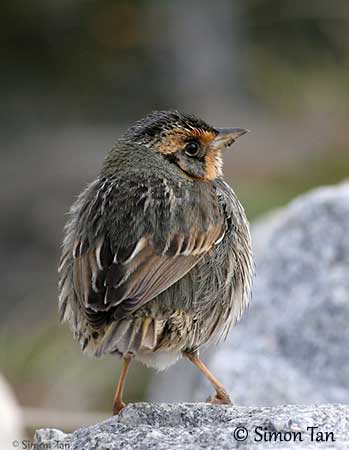
The nest is built by the female after mating. This is a cup-shaped nest made with grass stems and marsh vegetation. The cup is lined with softer grasses. A partial covering is sometimes built up on the sides. This structure is attached to several grass stems at about 6-10 centimetres above the ground or the water surface. The nest is usually placed in tidal grasses above the highest water level.
The female lays 3-5 pale greenish or bluish eggs with reddish-brown speckles. She incubates alone during 10-12 days. She feeds and cares for the chicks until they fledge, about 8-11 days after hatching. They may remain about 2-3 weeks more with the female.
Replacement clutch is usually laid if the first clutch is flooded out and lost. This species may produce two broods per season. It is a semi-colonial nester with several females nesting in close proximity of one another.
PROTECTION / THREATS / STATUS:
The Saltmarsh Sparrow is very sensitive to water level, and the species is threatened by the rising of sea level resulting from climate change and involving flooding of coastal salt marshes. In addition, urban development involves loss and fragmentation of its marshy habitat.
The global population was recently estimated to number 50,000/100,000 individuals, following the previous described threats and the restricted range of less than 20,000 km² extending in narrow coastal band. The suitable habitat is greatly fragmented and the effective occupied area by the birds is less than 2000 km².
The Saltmarsh Sparrow is currently listed as Vulnerable.
